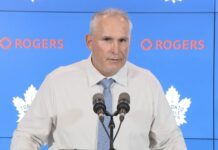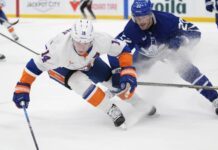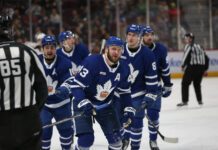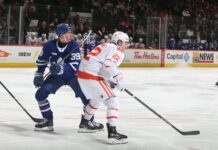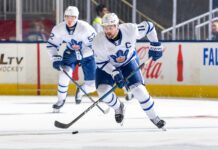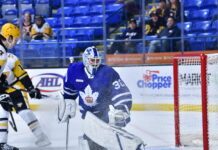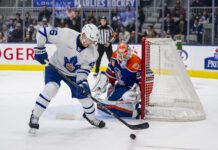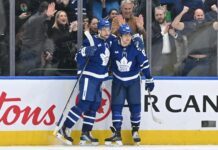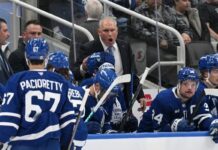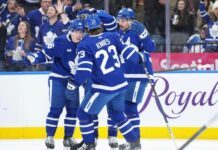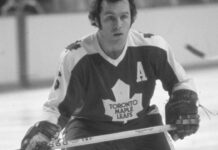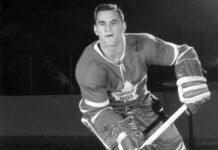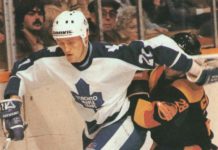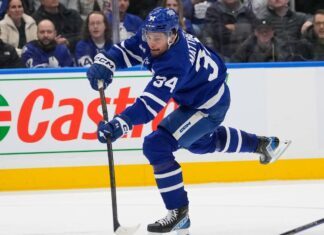Whether David Keon is the greatest Maple Leaf player of all time has been debated off and on for years.
(I would suggest that he may well be, as I wrote in an article for Maple Leafs Hot Stove and Yahoo! Sports a few years ago).
Regardless of one’s point of view on that subject, there’s no question Dave Keon deserves to be counted among the finest individuals ever to wear the Toronto Maple Leaf crest.
So the news that Keon will at long last be recognized by the organization this weekend as a new member of “Legends Row” provides a bit of closure for old-time (I was born in 1953) Leaf fans like myself, who grew up enthralled by Keon’s exploits in the 1960s.
Unfortunately, at various points along the way, the relationship between Keon and the Maple Leaf organization soured. And it has largely remained that way for decades. In fairness, the organization has tried for many years to include Keon when it comes to honouring former greats. But for (in my view) good reason, the former captain was not interested in a full reconciliation. While Keon has attended a few Leaf-related events in more recent times, there were decades where he was a largely a non-presence at any Leaf-related functions.
How did it ever come to that point—a situation where one of the finest men ever to represent team founder and owner Conn Smythe’s proud franchise was seemingly in exile?
A bit of background may help, as I try today to capture just a few personal memories of Keon’s time with the Maple Leafs. (If my memory is faulty on various points of reference, I’m sure the outstanding readers from MLHS will intercede and offer their own personal recollections…)
The early years
Most olden-days Leaf followers know the story—Keon, born and raised in Noranda, Quebec, was spotted by a Leaf scout (the late Bob Davidson, I believe) when he was in his early teens, or thereabouts. To get his rights (in those days, if I recall correctly, NHL teams held player rights through a kind of sponsorship system; there was no draft of any kind almost until the mid 1960s) the Maple Leafs basically bought his team, to ensure they had Keon wrapped up in case he turned out to be a good player later on.
He did.
Junior hockey
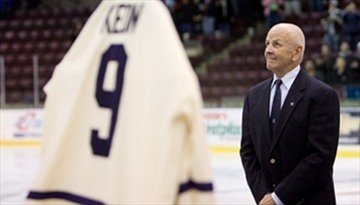 Keon played for St. Michael’s College, who in those days were, along with the Toronto Marlies, Major Junior franchises and part of the Maple Leaf hockey pipeline “family”. Toronto held the rights to virtually all of those players from either the Marlies or St. Mike’s. (There may have been exceptions—future Red Wing greats Ted Lindsay and Red Kelly come to mind as guys who may also have played at St. Mike’s, but I would have to double check that.) The young Keon had an outstanding junior career for St. Mike’s. Interestingly, Keon almost played for the Canadian National team at the 1960 U.S. Olympics. For reasons I cannot recall, he missed that opportunity (I believe future Montreal star Bobby Rousseau may have been the guy who took his place).
Keon played for St. Michael’s College, who in those days were, along with the Toronto Marlies, Major Junior franchises and part of the Maple Leaf hockey pipeline “family”. Toronto held the rights to virtually all of those players from either the Marlies or St. Mike’s. (There may have been exceptions—future Red Wing greats Ted Lindsay and Red Kelly come to mind as guys who may also have played at St. Mike’s, but I would have to double check that.) The young Keon had an outstanding junior career for St. Mike’s. Interestingly, Keon almost played for the Canadian National team at the 1960 U.S. Olympics. For reasons I cannot recall, he missed that opportunity (I believe future Montreal star Bobby Rousseau may have been the guy who took his place).
At St. Mike’s, Keon was a strong offensive player. Though he was smallish even by the standards of the time (5 foot 9 and maybe 160 pounds), he could skate and make plays. What he lacked, as the story goes, was a strong defensive game.
This became a project for his coach at the same, Fr. David Bauer. Fr. Bauer taught Keon a method of checking that allowed the young center to utilize his great speed and anticipation with the use of angles on the forecheck to thwart opponents. This fine-tuning turned out to be a game changer for the diminutive center.
Leaf camp
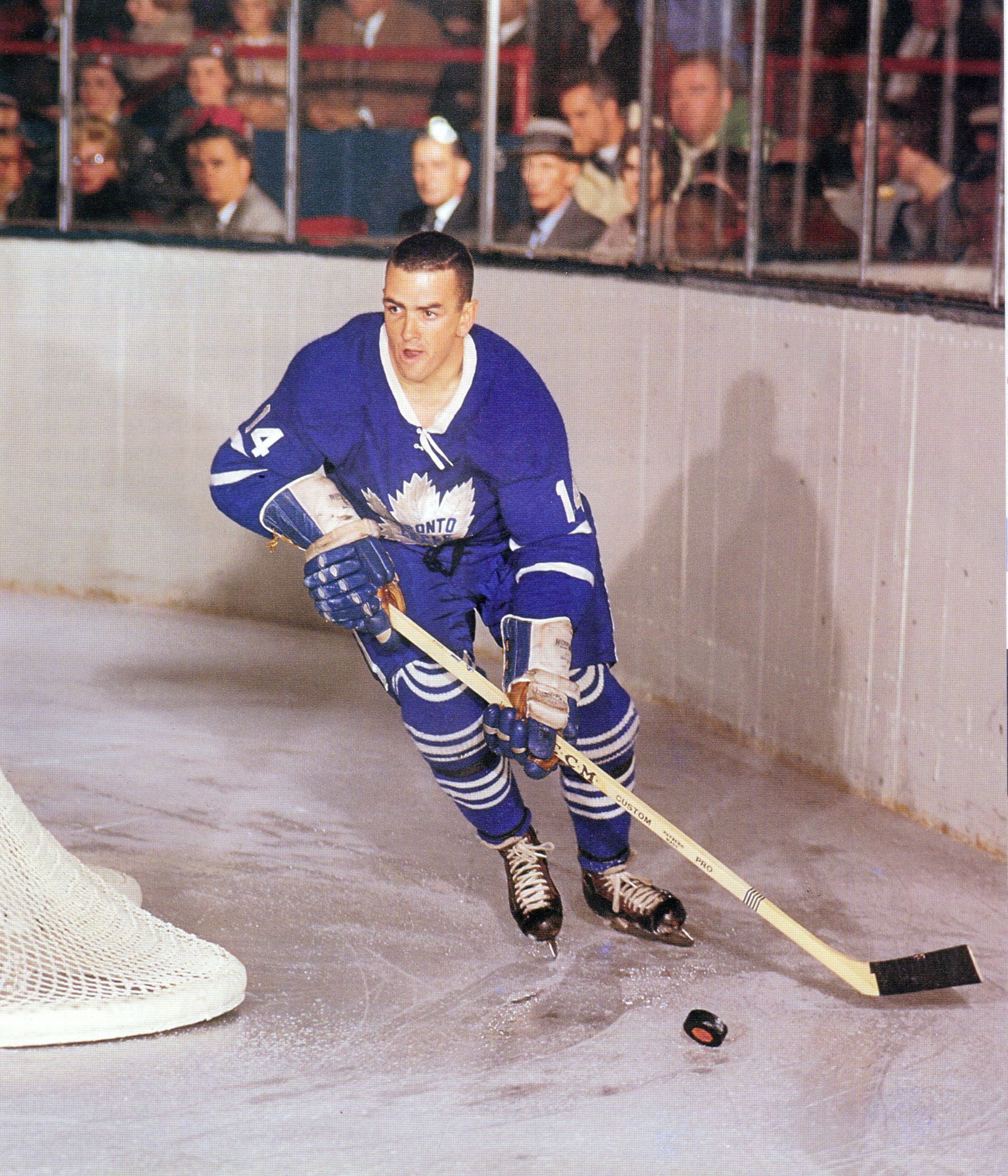 Keon was invited to Leaf camp in the fall of 1960, but was not expected to make the roster. Why? He was still a kid, and small at that. The NHL was a man’s league, and Toronto already had experienced centers like Bob Pulford, Red Kelly and Billy Harris on the roster. General Manager and coach Punch Imlach reasoned that Keon would need to get some seasoning in the minor leagues.
Keon was invited to Leaf camp in the fall of 1960, but was not expected to make the roster. Why? He was still a kid, and small at that. The NHL was a man’s league, and Toronto already had experienced centers like Bob Pulford, Red Kelly and Billy Harris on the roster. General Manager and coach Punch Imlach reasoned that Keon would need to get some seasoning in the minor leagues.
But during a late training camp west coast series of exhibition games (they didn’t call them “pre-season” games back then) against some minor league squads, Keon stood out such that Imlach felt the need to keep “Davey”, as he was called in his early Leaf days, on the big club’s roster.
Imlach never regretted his decision. Though his statistics that first year were solid but relatively modest (20 goals and 25 assists), Keon was named rookie of the year in the NHL, earning the prestigious Calder Trophy.
Early Leaf years
The Leafs were unexpectedly bounced from the playoffs in the spring of 1961 in the semi-finals, but went on to win three Stanley Cups in a row between 1962 and 1964. There were too many memorable playoff encounters to recount here. I will say this: the Leaf roster in 1962-’63 remains, in my view, the finest all-around Leaf team in my lifetime. They finished in first place in the NHL regular season standings—something they had not done in ages, and believe it or not, have not achieved since. (Keon, by the way, scored the pennant-clinching goal with a handful of seconds on the clock at Maple Leaf Gardens in a late season game against Jacques Plante and the hated Habs. The goal capped a dramatic come from behind 3-3 tie that night.) Toronto polished off the Canadiens and the Red Wings in only 10 playoff games to capture their second Cup in a row.
To be clear, those Leaf teams were much, much more than just Keon. Johnny Bower was splendid in goal, though Don Simmons was actually in net the night the Leafs won the championship in Chicago in April of 1962 against Bobby Hull, Glenn Hall, Stan Mikita and a great cast of Blackhawks. And Leaf fans well know the names of Baun and Brewer, Horton and Stanley, as well as those of Red Kelly, The “Big M’ (Frank Mahovlich), Pulford, Eddie Litzenberger, Ron Stewart, Eddie Shack and many others.
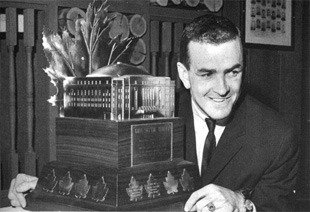
Keon was brilliant in those playoff years, and could certainly have been named playoff MVP in 1963 if such an honour existed at the time. In fact, Imlach wrote an article for Hockey Illustrated magazine at the time that was headlined, “I Wouldn’t Take a Million Dollars for Keon”. (Ironically, the Leafs had almost sold a star player, Frank Mahovlich, to Chicago for a million dollars a couple of years before that.)
Though the Leafs were eliminated in the playoffs in 1965 and 1966, Keon continued to be as consistent a center ice man as the Leafs have likely ever had. He was a peerless penalty killer, scored crucial goals (though scoring wasn’t actually his calling card in the NHL) and was called upon to check some of the best opposing centers in the league in those early years—a job he handled spectacularly well.
Consistency was his trademark. He was always on the move, checking, digging, eliminating guys from the play after they got rid of the puck. He created countless opportunities for linemates and killed penalties while also almost never taking a minor penalty himself. (As a young fan, I used to wish they kept statistics on how many times Keon caused the other team to take penalties, because he was so quick and relentless.)
In short, Keon was, in my estimation, possibly the finest all-around player in the NHL between 1960 and 1967. As former coach and Hockey Night in Canada analyst Harry Neale used to say, if you were building a complete hockey player, you would look at Keon, because he did all the things you look for in a player so well.)
The last Cup: 1967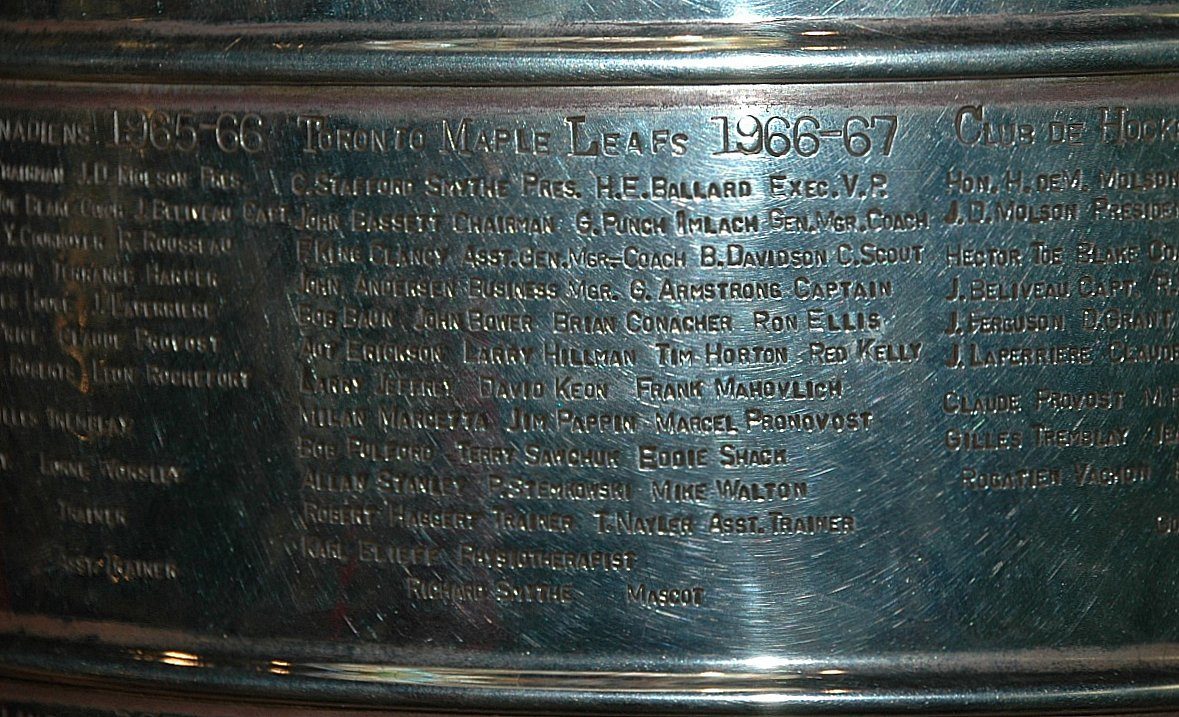
The Leafs had some young guys in the lineup through the 1966-’67 season, (Pete Stemkowski, Ron Ellis, Mike Walton, Brian Conacher, Jim Pappin, etc.) but were thought to be a mostly aging team on the decline.
They also suffered through a rather disconcerting 10-game losing streak in the winter of ’67, which coincided with Imlach spending time in hospital from a form of nervous exhaustion, according to published reports at the time.
But somehow the tandem of Bower and former Red Wing legend Terry Sawchuk combined to lead Toronto to two massive upsets—over first-place Chicago and the vaunted Canadiens. Keon was remarkable in both series, and by virtue not of his offensive prowess but because of his all-around play, was named winner of the Conn Smythe Trophy as playoff MVP.
End of the Imlach era
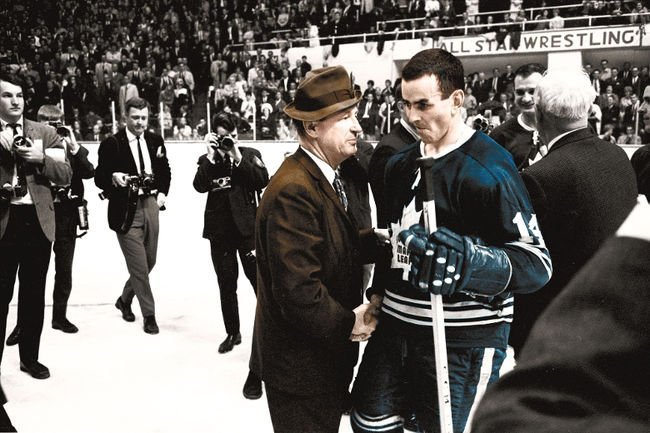
The next two seasons saw the Leaf decline re-start in earnest. They missed the playoffs the year after winning the Cup (the first year of expansion), and though they made the playoffs in the spring of 1969, they were crunched by a Bruins squad that was led by the incomparable Bobby Orr and would soon be known as “The Big Bad Bruins”.
Early 1970s
When Jim Gregory took over from the fired Imlach before the 1969-’70 NHL season, he began re-constructing the roster. Keon was named captain and had a very good season, though the team was in transition and missed the playoffs. I believe it was at training camp the next year that Keon first held out for a new contract, perhaps beginning the deterioration of his relationship with new Leaf owner Harold Ballard (Ballard had taken over control of the club after the death of his longtime partner, Stafford Smythe, Conn’s son.)
Keon had perhaps his finest season as a Leaf in 1970-’71, leading the resurgent Leaf squad to the playoffs and an exhilarating playoff series against a very good and rugged New York Rangers squad. Keon was named a second team end-of-season NHL All-Star, the second time he received that kind of year-end All-Star recognition.
The next season was an injury-plagued year for the Leaf leader. He had a bad knee, and while he played through the injury, he was not quite himself. He still led the team to the playoffs, only to be knocked off by a great Bruin side in April of 1972.
Partly because he had struggled with injuries and his stats were off from the years before, and partly because he was not an Al Eagleson “guy” (Eagleton, the head of the players’ union, had become a prominent decision-maker by the early ‘70s) Keon was not selected to play in the famous 1972 Summit Series involving Canada and the Soviet Union. I was shocked that Keon was not even invited to Team Canada’s training camp, given everything he had done during his 10 plus years in the league and the fact that he was a Leaf great already. Team Canada had a great roster, but could surely have used Keon.
Another of Keon’s finest individual campaigns came to pass in 1972-’73. That was the season the new World Hockey Association had signed a number of young Leaf players and the roster was not what it was in Gregory’s early years. But Keon stood tall. As broadcasting legend Foster Hewitt said one night (I was listening on an old radio in my college dormitory in the winter of ’73) that season: “Where would this Leaf team be without Dave Keon”.
That could have been said for a number of the Leaf teams that Keon was on. Where indeed?
Final Leaf years
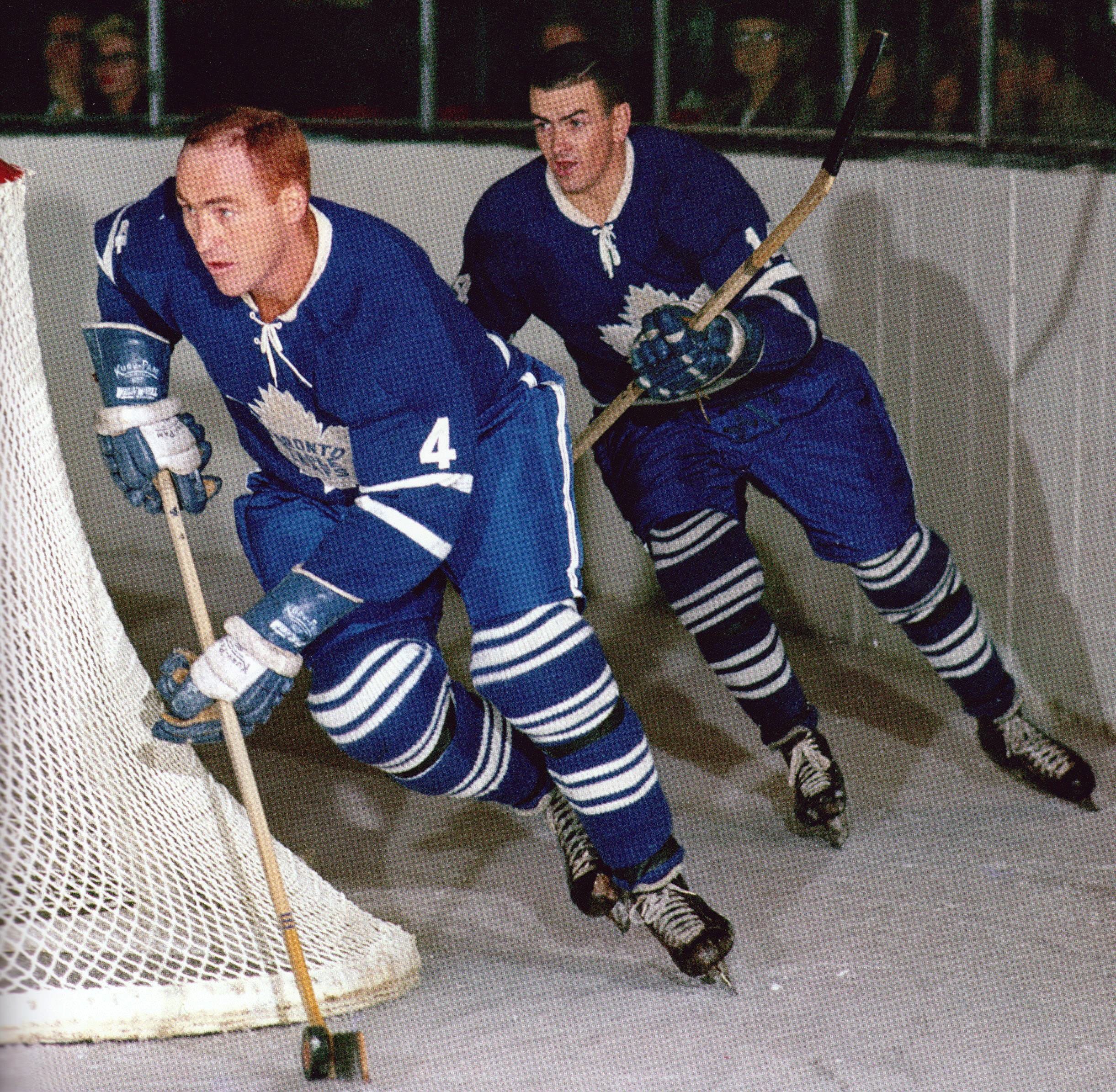
Keon’s final years in blue and white were played under former teammate Red Kelly. Kelly had coached the expansion Kings and Penguins before being hired by Ballard. But again, the team was in transition. Older veterans including Keon and Norm Ullman were still there, but youngsters like Lanny McDonald, Darryl Sittler, Borje Salming and Ian Turnbull were the hope for the future.
Another step in the deterioration of the relationship between the understandably proud Keon and the Leaf brass came when Ballard publicly criticized the team captain’s “leadership” in the Toronto daily newspapers early on during the 1974-’75 season. It was a direct hit on Keon, a guy who had bled blue and white and had given his heart and soul to the organization for well over a decade.
Perhaps Ballard was upset that Keon had supposedly considered jumping to the WHA a couple of years earlier, but regardless, the wound between Keon and Ballard was now wide open for all to see.
Last Leaf game
My last great memory of Keon as a Leaf? Toronto was playing the “Broad Street Bullies” in the playoffs in April of 1975. The Leafs were an improving team but not in the Flyer’s class. Philadelphia had one-time Leaf Bernie Parent in net with Bobby Clarke, Rick Macleish and a host of other stars and tough guys on the roster. They hammered the Leafs in four straight games. But in Game 4 at the Gardens, Keon made the play to set up the game’s opening goal. He fought to win the puck along the boards from Flyer tough guy Bob “Mad Dog” Kelly, and set up linemate Blaine Stougton (perhaps it was Ron Ellis, I’m trying to remember) for the goal. The Leafs ended losing 4-3 in overtime.
It was Keon’s last game with the Leafs.
Leaving the Leafs
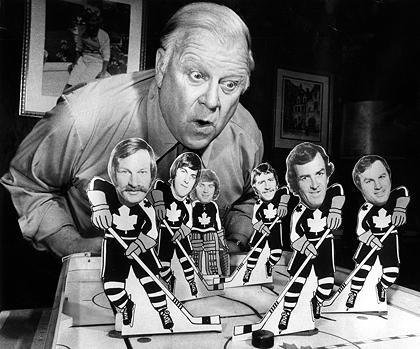 Keon was unceremoniously ignored by Ballard in the summer of `75. He was not offered a contract. In those days there was no ability for a player to sign elsewhere in the NHL. Their rights were still “owned” by the NHL team. So after 15 years with the Leafs, Keon had no alternative but to seek out the World Hockey Association. He signed with the Minnesota Fighting Saints.
Keon was unceremoniously ignored by Ballard in the summer of `75. He was not offered a contract. In those days there was no ability for a player to sign elsewhere in the NHL. Their rights were still “owned” by the NHL team. So after 15 years with the Leafs, Keon had no alternative but to seek out the World Hockey Association. He signed with the Minnesota Fighting Saints.
Keon toiled in the new league for the next several seasons. I did not get a chance to see him play often, but I followed his travels as closely as I could. Teams were folding in the new league, and he bounced around, playing twice in Minnesota, I believe, as well as in Indianapolis and finally, with Hartford/New England.
The former Leaf was still not fully freed from Ballard’s clutches, however. The emerging New York Islanders, in the late 1970s, were looking for a capable veteran center to fill a two-way role on what would soon become a hockey dynasty. They wanted Keon, but he could not simply leave the WHA and join Islanders coach Al Arbour, a former early 1960’s teammate with the Maple Leafs. The Islanders had to get permission from the Leafs to sign him, and Ballard insisted on some kind of compensation—in fact, so much compensation for a player he had no interest in that the Islanders never signed Keon. (Some time afterwards, the Islanders traded for LA King center Butch Goring, and Goring was one of the key last pieces on what soon became a four-time Stanley Cup champion on the Island in the early 1980s.)
Last NHL years
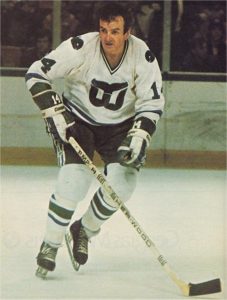 After four WHA clubs joined the NHL for the 1979-’80 season, Keon was still playing with the Whalers. At one point during that 79-’80 NHL season, he briefly played on a line with Gordie Howe and Bobby Hull, both also in the last stages of their memorable careers. That had to be one of the oldest lines in NHL history, if not the oldest. Interestingly, Keon had a career-high 52 assists that year.
After four WHA clubs joined the NHL for the 1979-’80 season, Keon was still playing with the Whalers. At one point during that 79-’80 NHL season, he briefly played on a line with Gordie Howe and Bobby Hull, both also in the last stages of their memorable careers. That had to be one of the oldest lines in NHL history, if not the oldest. Interestingly, Keon had a career-high 52 assists that year.
Keon played through the end of the 1981-82 season—mostly on some pretty mediocre Hartford squads. He was no longer the player he once was, of course, but he was still a determined, hard-working guy who showed up every night.
Statistics were far from the measure of the player, but for what it ‘s worth, he finished his combined NHL/WHA career having played 22 years, with 498 goals and 779 assists. Total penalty minutes? 137—which included a fighting major (it was more of a shoving match with Bruin forward Glen Sheppard during one of Keon’s last years with the Leafs) and a couple of misconducts. Eliminate those and he basically was called for 50 minor penalties—total—in 22 industrious seasons. That’s pretty remarkable.
Retirement years and a disconnect with the Leafs
Keon did not have a press conference to end his career. In fact, I’m not even sure if it was ever really a “news” item. He just quietly left. Many hockey people tried to get him to become involved in the game in some way, but he, by all accounts, essentially left the game behind upon retirement. He became involved in real estate but did not have much of a connection with the game.
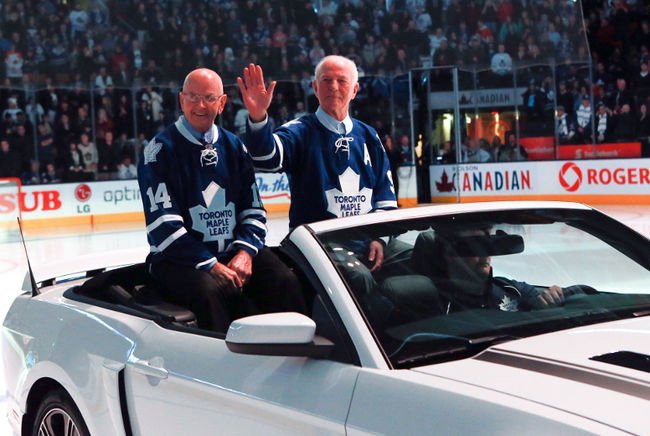
I recall that he made his first visit public back to the old Gardens in probably the late ‘80s, if I’m not mistaken. I think it was some kind of old-timers game, but I don’t believe it was officially connected with the Maple leaf organization. Of course he returned a few years ago when the 1963 championship team was honoured at the ACC and received a lengthy ovation. Unfortunately, the vast majority of those in the audience that night likely never saw him play in person or even on television. (Besides watching him every chance I had on TV, I was fortunate to see Keon play at the old Detroit Olympia as a kid. I grew up in a small town in southern Ontario across from Detroit and my Dad, a fervent Montreal fan, would sometimes take me to a game in Detroit. I also was able to see Keon play at the Gardens during the 1964-’65 season when I was all of 11 years old, and again in 1972-’73 while I was going to school in Toronto.)
Some suggest Keon’s supposed bitterness toward the Leafs stems from the fact that they did not retire his number. I don’t know whether that was a determining factor in Keon’s perspective regarding his relationship (or lack thereof) with the Leafs over the years or not. I do know that, like other great Leafs including Syl Apps, Teeder Kennedy, Bower and many others, he deserves to have his number retired. But for reasons I will never understand, the Leafs only ‘honour’ numbers.
Keon was every bit to Toronto and the Leafs what Henri Richard was to the Montreal Canadiens. Henri’s number is, quite rightly, retired in Montreal by an organization known for its history, tradition and class.
Sadly, while the Leafs are certainly known for their history, heritage and a meaningful hockey legacy, class is not a word that has been associated all too often with the Maple Leafs from an ownership perspective since Harold Ballard took over the reins in the early 1970s.
This point needs to be made
The media has largely painted Keon as something of a villain over the past 20 some years when it comes to his relationship with the Leafs. Too often he has been presented as a bitter former player who was carrying a grudge and couldn’t let go.
But it’s clear to me that Keon never, ever sought publicity from the media in any way since the day he left the NHL. It was always individuals within the media—many who may well have been fans of Keon in their earlier years—who would ask him why he would not attend Leaf functions. All Keon did, when he did respond, was to answer their direct questions honestly.
He never sought a platform to discuss this. In reality, it was quite the opposite. He seemed absolutely content to let the matter go. But the Leafs have persisted in seeking reconciliation with Keon while the media and even we fans also kept pushing for a thaw in the relationship.
In this regard I’m very much with Keon. He left the Leafs without saying a word. He left the NHL without saying a word. His lack of interest in being connected with Leaf activities is his personal business. Whether it dates back to Ballard’s unfair criticism of his captaincy as a Leaf at the end of his career, not being offered a contract by Ballard in the summer of 1975 (and therefore being pushed out of the NHL) or Ballard standing in the way of a prominent NHL return with a really good Islanders team in the late 1970s, I don’t know. It’s just as likely that there have been behind-the-scenes things done and said which none of us know a thing about that have caused a breakdown. Keon has seemingly been happy avoiding the spotlight and leading a quiet life in retirement—without the need for a connection with the Leaf organization.
Final reflections
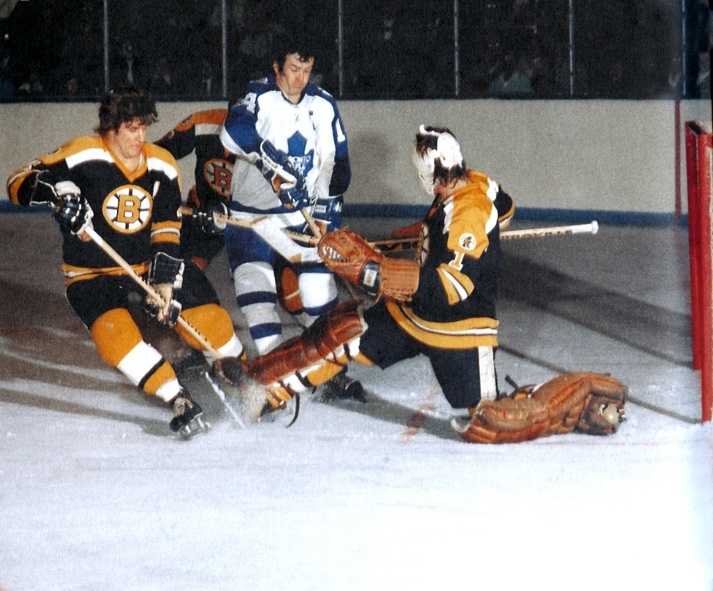 How tough was Keon to play against? I don’t recall the precise words, but I do remember an interview with former Bruin General Manager Harry Sinden from the early 1970s. He essentially said (during a Hockey Night in Canada profile) that Keon was the only guy in the league who made things a bit difficult for Bobby Orr. Hall of Fame defenseman Brad Park was asked about trying to handle the forecheck of top opposing forwards. I remember him saying, basically, that when it came to Keon, you didn’t even bother to try to get past him with the puck. You simply had to pass the puck to somebody else.
How tough was Keon to play against? I don’t recall the precise words, but I do remember an interview with former Bruin General Manager Harry Sinden from the early 1970s. He essentially said (during a Hockey Night in Canada profile) that Keon was the only guy in the league who made things a bit difficult for Bobby Orr. Hall of Fame defenseman Brad Park was asked about trying to handle the forecheck of top opposing forwards. I remember him saying, basically, that when it came to Keon, you didn’t even bother to try to get past him with the puck. You simply had to pass the puck to somebody else.
Keon wasn’t the greatest player of all time, but he was awfully good. He was one of the fastest players of his generation in his early years. He also developed one of the most dangerous backhand shots in the game (a lost art somewhere along the way over the past 30 plus years). He was an elite penalty killer as well as an unparalleled forechecker in his prime.
He led by example and by his on-ice work ethic, and he expected teammates to have the same dedication as he displayed and to play through injuries as he did. (This is a trait he apparently picked up from former Montreal great Bert Olmstead, a teammate with the Leafs in the early 1960s who passed away recently. Olmstead was a rugged player who always pushed his teammates to work harder.) This did not make Keon the easiest teammate to have, or everyone’s best buddy. He had exacting standards, and he rarely, I suspect, let himself—or Leaf fans—down.
There were few, if any nights, where he did not give his all.
So being honored as part of “Legends Row”(along with the also deserving Tim Horton and Turk Broda), while not the retired-number best-case scenario, is certainly a fitting if belated tribute to the best Maple Leaf of my generation. For those like myself who were “raised” on the Leafs when we first fell in love with hockey in the late 1950s and early 1960s, the number 14 will always represent the Maple Leaf logo—and Dave Keon.
Toronto Maple Leafs All-Time Points
| Player | Pos | GP | G | A | PTS | +/- | PIM | EV | PP | SH | GW | S | S% |
|---|---|---|---|---|---|---|---|---|---|---|---|---|---|
| Mats Sundin* | C/RW | 981 | 420 | 567 | 987 | 99 | 748 | 273 | 124 | 23 | 79 | 3104 | 13.5 |
| Darryl Sittler* | C | 844 | 389 | 527 | 916 | 34 | 763 | 261 | 120 | 8 | 42 | 3142 | 12.4 |
| Dave Keon* | C | 1062 | 365 | 493 | 858 | 63 | 75 | 212 | 54 | 25 | 49 | 2007 | 10.2 |
| Ron Ellis | RW | 1034 | 332 | 308 | 640 | 67 | 207 | 269 | 56 | 7 | 51 | 1909 | 14 |
| Rick Vaive | RW | 534 | 299 | 238 | 537 | -66 | 940 | 198 | 90 | 11 | 31 | 1771 | 16.9 |
| George Armstrong* | RW/C | 1187 | 296 | 417 | 713 | 15 | 721 | 80 | 21 | 3 | 19 | 414 | 10.6 |
| Frank Mahovlich* | LW/C | 720 | 296 | 301 | 597 | 1 | 782 | 89 | 29 | 0 | 21 | 151 | 12.6 |
| Wendel Clark | LW | 608 | 260 | 181 | 441 | -90 | 1535 | 181 | 79 | 0 | 38 | 1811 | 14.4 |
| Bob Pulford* | LW/C | 947 | 251 | 312 | 563 | -40 | 691 | 91 | 25 | 15 | 13 | 635 | 7.7 |
| Ted Kennedy* | C | 696 | 231 | 329 | 560 | 432 | |||||||
| Lanny McDonald* | RW | 477 | 219 | 240 | 459 | 89 | 372 | 150 | 59 | 10 | 22 | 1570 | 13.9 |
| Syl Apps* | C | 423 | 201 | 231 | 432 | 56 | |||||||
| Charlie Conacher* | RW | 326 | 200 | 124 | 324 | 411 | |||||||
| John Anderson | RW/LW | 534 | 189 | 204 | 393 | -33 | 168 | 139 | 49 | 1 | 27 | 1262 | 15 |
| Busher Jackson* | LW | 432 | 186 | 165 | 351 | 342 | |||||||
| Sid Smith | LW | 601 | 186 | 183 | 369 | 94 | |||||||
| Ron Stewart | RW/C | 838 | 186 | 182 | 368 | 413 | 26 | 2 | 2 | 6 | |||
| Phil Kessel | RW | 446 | 181 | 213 | 394 | -79 | 140 | 128 | 52 | 1 | 31 | 1663 | 10.9 |
| Gary Leeman | D/LW/RW | 545 | 176 | 231 | 407 | -76 | 463 | 127 | 43 | 6 | 11 | 1359 | 13 |
| Dick Duff* | LW | 582 | 174 | 168 | 342 | 535 | 5 | 2 | 0 | 0 | |||
| Babe Dye* | RW | 177 | 173 | 42 | 215 | 190 | |||||||
| Norm Ullman* | C | 535 | 166 | 305 | 471 | 53 | 160 | 118 | 46 | 2 | 10 | 1392 | 11.9 |
| Harry Watson* | LW | 500 | 163 | 122 | 285 | 111 | |||||||
| Paul Henderson | LW | 408 | 162 | 156 | 318 | 84 | 166 | 125 | 36 | 1 | 22 | 1142 | 14.2 |
| Tod Sloan | RW/C | 549 | 162 | 184 | 346 | 650 | |||||||
| Bill Derlago | C | 378 | 158 | 176 | 334 | -54 | 179 | 118 | 33 | 7 | 13 | 945 | 16.7 |
| Borje Salming* | D | 1099 | 148 | 620 | 768 | 155 | 1292 | 98 | 44 | 6 | 13 | 2484 | 6 |
| Darcy Tucker | LW/RW/C | 531 | 148 | 171 | 319 | -1 | 756 | 83 | 61 | 4 | 29 | 1024 | 14.5 |
| Doug Gilmour* | C | 393 | 131 | 321 | 452 | 55 | 386 | 78 | 46 | 7 | 13 | 838 | 15.6 |
| Nick Metz | C/LW | 518 | 131 | 119 | 250 | 149 | |||||||
| Gordie Drillon* | RW | 262 | 127 | 117 | 244 | 42 | |||||||
| Sergei Berezin | LW/RW | 357 | 126 | 94 | 220 | 20 | 34 | 91 | 34 | 1 | 16 | 1104 | 11.4 |
| Errol Thompson | LW | 365 | 126 | 119 | 245 | 39 | 70 | 92 | 30 | 4 | 18 | 864 | 14.6 |
| Nik Antropov | C/RW | 509 | 125 | 166 | 291 | 54 | 477 | 95 | 27 | 3 | 22 | 937 | 13.3 |
| Reg Noble* | LW | 160 | 125 | 59 | 184 | 329 | |||||||
| Max Bentley* | C | 354 | 122 | 134 | 256 | 132 | |||||||
| Dave Andreychuk | LW/RW | 223 | 120 | 99 | 219 | 16 | 194 | 60 | 53 | 7 | 15 | 840 | 14.3 |
| Red Kelly* | C | 470 | 119 | 232 | 351 | 74 | 41 | 9 | 1 | 5 | |||
| Vincent Damphousse | C/LW | 394 | 118 | 211 | 329 | -41 | 262 | 87 | 30 | 1 | 16 | 919 | 12.8 |
| Tom Fergus | C | 357 | 118 | 179 | 297 | -90 | 324 | 88 | 26 | 4 | 10 | 723 | 16.3 |
| Steve Thomas | LW/RW | 377 | 118 | 173 | 291 | -4 | 299 | 89 | 29 | 0 | 29 | 968 | 12.2 |
| Ed Olczyk | RW/C | 257 | 116 | 151 | 267 | -29 | 221 | 79 | 31 | 6 | 11 | 745 | 15.6 |
| Miroslav Frycer | RW | 329 | 115 | 153 | 268 | -67 | 374 | 92 | 23 | 0 | 14 | 745 | 15.4 |
| Alexei Ponikarovsky | RW/LW | 477 | 114 | 143 | 257 | 56 | 318 | 91 | 19 | 4 | 12 | 989 | 11.5 |
| Ian Turnbull | D | 580 | 112 | 302 | 414 | 32 | 651 | 76 | 32 | 4 | 9 | 1848 | 6.1 |
| Ace Bailey* | RW | 313 | 111 | 82 | 193 | 472 | |||||||
| Tim Horton* | D | 1185 | 109 | 349 | 458 | 38 | 1389 | 36 | 15 | 2 | 14 | 464 | 3.9 |
| Sweeney Schriner* | LW | 244 | 109 | 83 | 192 | 75 | |||||||
| Tiger Williams | LW | 407 | 109 | 132 | 241 | 0 | 1670 | 86 | 23 | 0 | 13 | 815 | 13.4 |
| Billy Harris | C | 610 | 106 | 181 | 287 | 187 | 6 | 1 | 0 | 2 | |||
| Daniel Marois | RW | 285 | 106 | 80 | 186 | -55 | 346 | 75 | 31 | 0 | 8 | 621 | 17.1 |
| Lorne Carr | RW | 236 | 105 | 121 | 226 | 37 | |||||||
| Tyler Bozak | C | 418 | 104 | 157 | 261 | -68 | 120 | 64 | 35 | 5 | 14 | 655 | 15.9 |
| Peter Ihnacak | C | 417 | 102 | 165 | 267 | -45 | 175 | 74 | 28 | 0 | 5 | 657 | 15.5 |
| Eddie Shack | LW/RW | 504 | 99 | 96 | 195 | -7 | 676 | 53 | 9 | 0 | 14 | 96 | 9.4 |
| Corb Denneny | LW/C | 135 | 98 | 41 | 139 | 130 | |||||||
| Bob Davidson | LW/C | 491 | 94 | 160 | 254 | 398 | |||||||
| Mark Osborne | RW/LW | 426 | 94 | 160 | 254 | -24 | 563 | 70 | 15 | 9 | 11 | 702 | 13.4 |
| Mikhail Grabovski | C | 340 | 91 | 117 | 208 | -1 | 237 | 67 | 23 | 1 | 12 | 728 | 12.5 |
| Russ Courtnall | C/RW | 309 | 90 | 128 | 218 | -61 | 243 | 64 | 13 | 13 | 9 | 867 | 10.4 |
| James van Riemsdyk | LW | 250 | 89 | 89 | 178 | -45 | 125 | 58 | 28 | 3 | 10 | 796 | 11.2 |
| Dan Daoust | C | 518 | 87 | 166 | 253 | -91 | 540 | 59 | 19 | 9 | 6 | 707 | 12.3 |
| Joffrey Lupul | C/LW | 273 | 87 | 94 | 181 | -32 | 161 | 64 | 23 | 0 | 11 | 690 | 12.6 |
| Matt Stajan | C | 445 | 87 | 136 | 223 | -2 | 247 | 62 | 18 | 7 | 12 | 619 | 14.1 |
| Hap Day* | LW | 538 | 86 | 113 | 199 | 587 | |||||||
| Inge Hammarstrom | LW | 292 | 85 | 82 | 167 | 12 | 74 | 71 | 14 | 0 | 14 | 654 | 13 |
| Tie Domi | RW | 777 | 84 | 112 | 196 | -32 | 2265 | 75 | 9 | 0 | 8 | 767 | 11 |
| Nikolai Kulemin | LW | 421 | 84 | 111 | 195 | -8 | 112 | 74 | 8 | 2 | 14 | 707 | 11.9 |
| Mike Walton | C/RW | 257 | 84 | 107 | 191 | -33 | 184 | 52 | 32 | 0 | 16 | 753 | 10.1 |
| Tomas Kaberle | D | 878 | 83 | 437 | 520 | 25 | 246 | 51 | 31 | 1 | 16 | 1337 | 6.2 |
| Terry Martin | LW | 317 | 83 | 76 | 159 | -34 | 152 | 69 | 11 | 3 | 8 | 441 | 18.8 |
| Bryan McCabe | D | 523 | 83 | 214 | 297 | 63 | 785 | 33 | 50 | 0 | 15 | 1154 | 7.2 |
| Howie Meeker | RW | 346 | 83 | 102 | 185 | 329 | |||||||
| Gary Roberts | LW | 237 | 83 | 74 | 157 | 19 | 266 | 50 | 28 | 5 | 12 | 406 | 20.4 |
| Al Iafrate | D | 472 | 81 | 169 | 250 | -84 | 546 | 57 | 18 | 6 | 12 | 792 | 10.2 |
| Jim McKenny | D | 594 | 81 | 246 | 327 | -2 | 292 | 56 | 23 | 2 | 7 | 1109 | 7.2 |
| Gaye Stewart | LW | 165 | 81 | 52 | 133 | 43 | |||||||
| Jack Adams* | C | 133 | 78 | 31 | 109 | 300 | |||||||
| Jonas Hoglund | LW | 325 | 78 | 106 | 184 | 12 | 62 | 59 | 17 | 2 | 15 | 767 | 10.2 |
| Wilf Paiement | RW | 187 | 78 | 125 | 203 | -27 | 420 | 47 | 27 | 4 | 5 | 647 | 12.1 |
| Joe Klukay | LW/RW | 416 | 76 | 94 | 170 | 138 | |||||||
| Andy Blair | C | 358 | 74 | 83 | 157 | 290 | |||||||
| Nazem Kadri | C | 294 | 72 | 104 | 176 | -7 | 171 | 54 | 17 | 1 | 5 | 669 | 10.8 |
| Harry Cameron* | D | 105 | 71 | 45 | 116 | 127 | |||||||
| Baldy Cotton | LW | 285 | 68 | 88 | 156 | 252 | |||||||
| Bill Thoms | C/D | 279 | 68 | 92 | 160 | 115 | |||||||
| Joe Primeau* | C | 310 | 66 | 177 | 243 | 105 | |||||||
| Billy Taylor | C | 222 | 66 | 118 | 184 | 60 | |||||||
| Greg Terrion | LW | 427 | 66 | 103 | 169 | -40 | 217 | 51 | 2 | 13 | 5 | 473 | 14 |
| Dan Maloney | LW | 270 | 65 | 84 | 149 | -20 | 538 | 50 | 15 | 0 | 9 | 416 | 15.6 |
| Alexander Mogilny | RW | 176 | 65 | 101 | 166 | 14 | 32 | 47 | 14 | 4 | 14 | 445 | 14.6 |
| Glenn Anderson* | RW | 221 | 63 | 94 | 157 | 0 | 267 | 42 | 21 | 0 | 10 | 476 | 13.2 |
| Buzz Boll | LW | 213 | 61 | 39 | 100 | 69 | |||||||
| Igor Korolev | RW | 297 | 60 | 101 | 161 | 8 | 118 | 40 | 14 | 6 | 11 | 375 | 16 |
| Pat Boutette | RW/LW | 349 | 59 | 82 | 141 | 9 | 520 | 52 | 7 | 0 | 6 | 426 | 13.8 |
| Todd Gill | D | 639 | 59 | 210 | 269 | -72 | 922 | 44 | 14 | 1 | 11 | 864 | 6.8 |
| Rick Kehoe | RW | 184 | 59 | 72 | 131 | 7 | 32 | 52 | 7 | 0 | 8 | 471 | 12.5 |
| Rudy Migay | C | 418 | 59 | 92 | 151 | 293 | |||||||
| Walt Poddubny | C/LW | 186 | 59 | 86 | 145 | 2 | 178 | 39 | 20 | 0 | 4 | 389 | 15.2 |
| Cal Gardner | C | 220 | 58 | 95 | 153 | 129 |


